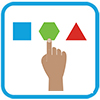Inclusion in schools: ADHD
30 January 2019
Attention deficit hyperactivity disorder (ADHD) can cause children to have trouble focusing, to not be able to sit still for long periods of time and to act before they think. A lot of children have trouble with these things, but in children with ADHD, this behaviour is extreme and has a big impact on their daily lives and their ability to meet the expectations of different learning environments.
Inclusion in schools: Vision impairment
4 October 2018
In the second of our series of Inclusion in schools articles, we take a look at vision impairment. Vision impairment can vary significantly from student to student, depending on the type, extent and timing of when the vision loss happened in their lives.
Inclusion in schools: Dyslexia
17 July 2018
In the first of our series of Inclusion in schools articles, we take a look at Dyslexia. If a student has dyslexia, they have difficulty with reading and spelling. They struggle to match the letters on the page with the sounds those letters, and combinations of letters, make.
Tips for inclusive communication in the classroom
23 March 2018
The idea of inclusive communication comes from an understanding that people communicate differently, and various techniques are needed to meet these different needs. The idea of inclusive communication comes from an understanding that people communicate differently, and various techniques are needed to meet these different needs.
Stories about Social Stories
16 December 2016
Our guest blogger, Psychologist Holly Melrose MAPS, has written a terrific piece on the use of social stories in connecting with children and adolescents.
Modelling behaviours so our expectations are clear
25 August 2016
When we take a new batch of children into our care, as our class for the year or as our clients, we can’t really know what knowledge, skills and understanding they will bring with them. Regardless of how many assessments, reports and files we read before we meet them, how the child presents could be completely different for a range of reasons. It’s important that we make our expectations clear from the very beginning so there is no chance your message isn’t being conveyed.
What is your learning style?
14 June 2016

Have you heard the saying, you can’t judge an elephant on how well they climb a tree? This is because everyone learns differently. Every brain sees, stores and processes information differently.
Why use visuals?
6 June 2016

Providing information in a visual format can be an extremely valuable way to communicate with an audience. There are many advantages to sharing information in visual ways.
What makes a good teaching resource?
2 April 2016

Choosing and using resources can be a minefield for teachers, professionals and parents. How do you know what’s good and what’s not until you’ve tried and tested it? When do you invest?
Use this simple set of questions to work it out.
What are we doing today?
28 March 2016

Using a visual schedule can be a positive strategy for supporting kids in the classroom and can make that transition from home to school or other activities so much easier. Learn how to use this tool to make the day easier for teacher, child and parent.
